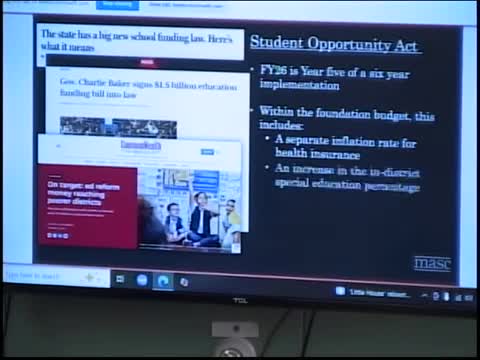Massachusetts increases funding for low income and English learner students in new budget
May 13, 2025 | Town of Hubbardston, Worcester County, Massachusetts
This article was created by AI summarizing key points discussed. AI makes mistakes, so for full details and context, please refer to the video of the full meeting. Please report any errors so we can fix them. Report an error »

In the heart of Hubbardston, Massachusetts, a recent government meeting brought to light significant changes in funding for education, particularly focusing on special education, English language learners, and low-income students. As members of the Select Board and Finance Committee gathered, the discussions revealed a commitment to addressing the evolving needs of the community's youth.
One of the key topics was the increase in funding for special education, which is now based on enrollment figures. This adjustment reflects a broader understanding of the challenges faced by students requiring additional support. The meeting highlighted a phased approach to funding, which aims to reach a set goal over the next six years, ensuring that resources align with the growing needs of the district.
Moreover, the committee discussed the financial increments allocated for English language learners and low-income students. These adjustments are not merely numbers on a budget sheet; they represent a recognition of the unique challenges faced by these groups. The funding for low-income students, in particular, has been identified as a critical area of focus, stemming from a study conducted in 2015 that underscored the significant needs of districts with high concentrations of low-income students.
The conversation also touched on the implications of the Student Opportunity Act, which has shifted the funding landscape. Originally intended for a seven-year implementation, the timeline was condensed to six years due to unforeseen delays. This change emphasizes the urgency of addressing educational disparities, particularly as child poverty rates have risen in Massachusetts since the pandemic.
As the meeting progressed, members were reminded of the foundational costs associated with educating a child, which include everything from teacher salaries to classroom supplies. The discussion underscored the importance of accurate enrollment reporting, which directly impacts funding calculations. The October 1 report serves as a crucial benchmark, determining the financial resources available for the following academic year.
In a notable shift, the state has moved towards a community eligibility model for determining low-income status, allowing for a more comprehensive and accurate count of students in need. This change aims to streamline the process and ensure that more students receive the support they require.
As the meeting concluded, it was clear that Hubbardston is at a pivotal moment in its educational funding journey. With a renewed focus on equity and support for vulnerable populations, the community is poised to make strides in providing a fair and adequate education for all its students. The discussions held in this meeting will undoubtedly shape the future of education in the district, reflecting a commitment to inclusivity and support for every child.
One of the key topics was the increase in funding for special education, which is now based on enrollment figures. This adjustment reflects a broader understanding of the challenges faced by students requiring additional support. The meeting highlighted a phased approach to funding, which aims to reach a set goal over the next six years, ensuring that resources align with the growing needs of the district.
Moreover, the committee discussed the financial increments allocated for English language learners and low-income students. These adjustments are not merely numbers on a budget sheet; they represent a recognition of the unique challenges faced by these groups. The funding for low-income students, in particular, has been identified as a critical area of focus, stemming from a study conducted in 2015 that underscored the significant needs of districts with high concentrations of low-income students.
The conversation also touched on the implications of the Student Opportunity Act, which has shifted the funding landscape. Originally intended for a seven-year implementation, the timeline was condensed to six years due to unforeseen delays. This change emphasizes the urgency of addressing educational disparities, particularly as child poverty rates have risen in Massachusetts since the pandemic.
As the meeting progressed, members were reminded of the foundational costs associated with educating a child, which include everything from teacher salaries to classroom supplies. The discussion underscored the importance of accurate enrollment reporting, which directly impacts funding calculations. The October 1 report serves as a crucial benchmark, determining the financial resources available for the following academic year.
In a notable shift, the state has moved towards a community eligibility model for determining low-income status, allowing for a more comprehensive and accurate count of students in need. This change aims to streamline the process and ensure that more students receive the support they require.
As the meeting concluded, it was clear that Hubbardston is at a pivotal moment in its educational funding journey. With a renewed focus on equity and support for vulnerable populations, the community is poised to make strides in providing a fair and adequate education for all its students. The discussions held in this meeting will undoubtedly shape the future of education in the district, reflecting a commitment to inclusivity and support for every child.
View full meeting
This article is based on a recent meeting—watch the full video and explore the complete transcript for deeper insights into the discussion.
View full meeting
